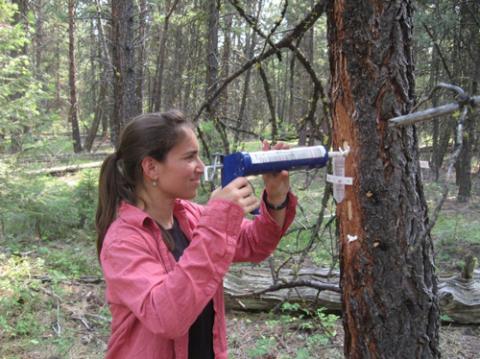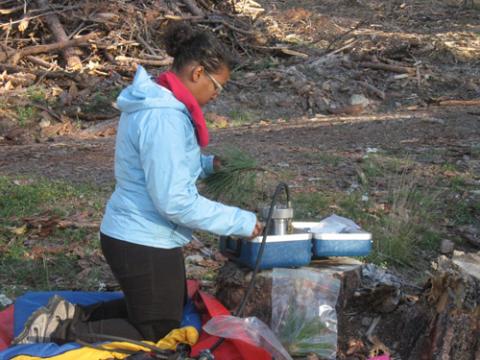Disturbance and disturbance interactions drive multiple ecosystem processes over multiple spatial and temporal scales. This project investigated the role of frequent, low-severity fire in Pinus ponderosa (ponderosa pine) forests in altering the success of the irruptive insect Dendroctonus ponderosae (mountain pine beetle (MPB)). We first explored the factors controlling constitutive defenses without fire and then studied the impact of low severity on tree defenses.
Factors controlling constitutive defenses
Bark beetles (Coleoptera: Curculionidae, Scolytinae) cause widespread tree mortality in coniferous forests worldwide. Constitutive and induced host defenses are important factors in an individual tree’s ability to survive an attack and in bottom-up regulation of bark beetle population dynamics, yet quantifying defense levels is often difficult. For example, in Pinus spp. resin flow is important for resistance to bark beetles, but is extremely variable among individuals and within a season. While resin is produced and stored in resin ducts, the specific resin duct metrics that best correlate with resin flow remain unclear. The ability and timing of some pine species to produce induced resin is also not well understood. We investigated (1) the relationships between resin flow and axial resin duct characteristics, tree growth, and physiological variables and (2) if mechanical wounding induces ponderosa pine resin flow and resin ducts in the absence of bark beetles. Resin flow increased later in the growing season under moderate water stress and was highest in faster growing trees. The best predictors of resin flow were non-standardized measures of resin ducts, resin duct size and total resin duct area, both of which increased with tree growth. However, while faster growing trees tended to produce more resin, models of resin flow using only tree growth were not statistically significant. Further, the standardized measures of resin ducts, density and duct area relative to xylem area, decreased with tree growth rate, indicating that slower growing trees invested more in resin duct defenses per unit area of radial growth, despite a tendency to produce less resin overall. We also found that mechanical wounding induced ponderosa pine defenses, but this response was slow. Resin flow increased after 28 days and resin duct production did not increase until the following year. These slow induced responses may allow unsuccessfully attacked or wounded trees to resist future bark beetle attacks. Forest management that encourages healthy, vigorously growing trees will also favor larger resin ducts, thereby conferring increased constitutive resistance to bark beetle attacks.
Impact of low-severity fire on tree defenses
Induced defense is a common plant strategy in response to herbivory. Although abiotic damage such as physical wounding, pruning, and heating can induce plant defense, the effect of such damage by large-scale abiotic disturbances on induced defenses has not been explored, and could have important consequences for plant survival facing future biotic disturbances. Historically, low-severity wildfire was a widespread, frequent abiotic disturbance in many temperate coniferous forests. Native Dendroctonus and Ips bark beetles are also a common biotic disturbance agent in these forest types and can influence tree mortality patterns after wildfire. Therefore, species living in these disturbance-prone environments with strategies to survive both frequent fire and bark beetle attack should be favored. One such example is Pinus ponderosa forests of western North America. These forests are susceptible to bark beetle attack and frequent, low-severity fire was common prior to European settlement. However, since the late 1800s frequent, low-severity fires have greatly decreased in these forests. We hypothesized that non-lethal, low-severity wildfire induces resin duct defense in P. ponderosa and that lack of low-severity fire relaxes resin duct defense in forests dependent on frequent, low-severity fire. We first compared axial resin duct traits between trees that either survived or died from bark beetle attacks. Next, we studied axial ducts using tree cores with crossdated chronologies in several natural P. ponderosa stands before and after an individual wildfire and also before and after an abrupt change in fire frequency in the 20th century. We show that trees killed by bark beetles invested less in resin ducts relative to trees that survived attack, suggesting that resin duct-related traits provide resistance against bark beetles. We then show low-severity fire induces resin duct production, and finally, that resin duct production declines when fire ceases. Our results demonstrate that low-severity fire can trigger a long-lasting induced defense that may increase tree survival from subsequent herbivory.
See also: Fuel treatment impacts in ponderosa pine - Douglas-fir forests in the Northern Rockies

